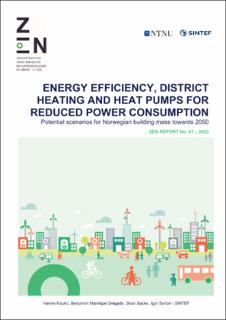| dc.description.abstract | Energy efficiency, district heating and heat pumps for reduced power consumption
The Norwegian power system is facing enormous challenges in the transition to a fossil-free society. The on-going electrification of transport and industry, together with establishment of new power-intensive industries, calls for rapid and extensive increase in both production of renewable electricity and the transmission grid capacity. This increase could partly be avoided through energy efficiency measures, heat pump adoption, and the use of alternative energy carriers for heating. Reduced energy delivered to buildings together with increased use of district heating have a great potential to reduce Norwegian electricity demand, and at the same time contribute to increased energy system flexibility when the grid is under the highest load.
The aim of this study was to quantify the potential for increased use of district heating and heat pumps on reducing buildings’ future electricity demand in Norway. The future energy demand of the Norwegian building stock, divided into three different groups with regards to population density, was first modelled in different scenarios with respect to energy efficiency and potential access to district heating network. The outcome was then applied in an energy system model to account for different energy sources and the flexibility available in the production of district heating.
The study shows that increased use of district heating reduces buildings’ electricity consumption, and in particular the buildings’ peak power demand. Comparing to 2020 level, continuing with business-as-usual will lead to 3% increase in buildings’ electricity demand by 2030, and +7% by 2050. The corresponding increase in buildings’ peak power demand is +2% by 2030 and +5% by 2050. Maximizing the use of district heating without ambitious energy efficiency standards will allow the buildings’ electricity demand to remain at the 2020 level, while buildings’ peak power demand could be reduced with -1% by 2030 and -5% by 2050.
A net reduction in both total electricity and peak power demand in buildings is achieved only when maximal use of district heating is combined with ambitious energy efficiency standards and maximising the use of heat pumps in rural areas where district heating is not feasible. This scenario allowed a reduction of -12% in buildings’ electricity demand by 2030 and -26% by 2050, compared to 2020 levels. The buildings’ peak power demand could be reduced with -17% by 2030 and -35% by 2050.
The results are of utmost importance for all stakeholders involved in the development of the energy system in Norway, at local and national level. Cold periods in the winter, and the inefficient use of electricity for heating, are the driving force for investments in the power system. Massive extension in the power production and transmission capacity can be partially avoided with strong emphasis on buildings’ energy efficiency, together with the use of district heating in urban areas and heat pumps in rural areas. This can reduce the total system costs for energy production and spare the natural environment for unnecessary further intervention. | en_US |
